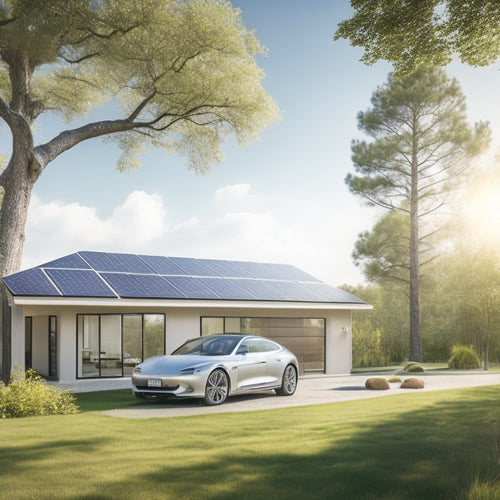
7 Electric Motorcycle Design Tips for Beginners
Share
When designing an electric motorcycle, you'll need to define your objective, choosing a battery that balances range and weight. Select an electric motor that suits your power needs, and optimize ergonomics for rider comfort. Balance power and efficiency to achieve the perfect ride. Don't forget essential safety features, such as crash protection zones and emergency shut-off systems. Prototyping and testing will help refine your design. As you navigate these vital steps, you'll uncover the intricacies of electric motorcycle design, and discover how to create a machine that's both powerful and sustainable. What other key factors will you uncover in your design journey?
Key Takeaways
• Define design objectives based on requirements and audience preferences to create a clear direction for your electric motorcycle design.
• Choose the right battery type considering chemistry, charging cycles, voltage, and capacity to ensure optimal performance and range.
• Select an electric motor that balances power output, torque, and efficiency to achieve the desired performance and range.
• Implement ergonomic design principles to reduce rider fatigue, incorporating features like optimized seat geometry, handlebar positioning, and footpeg placement.
• Validate your design through prototyping and testing, iterating on the design based on test results to ensure safety, performance, and regulatory compliance.
Defining the Design Objective
To successfully design an electric motorcycle, you must first define the design objective by identifying the specific requirements and constraints that will shape your project's scope, budget, and timeline. This involves understanding your target audience and their needs. Are you designing for commuters or thrill-seekers? What's their preferred riding style, and what kind of terrain will they encounter? By pinpointing your target audience, you'll be able to tailor your design to meet their specific requirements.
Your design philosophy will also play a vital role in shaping your project's direction. Will you prioritize performance, efficiency, or sustainability? Perhaps you'll aim for a sleek, aerodynamic design or focus on creating a rugged, off-road beast. Whatever your philosophy, it's crucial to establish a clear vision that guides your design decisions.
Choosing the Right Battery
With your design objective defined, you're now ready to select the battery that will power your electric motorcycle, and this critical component's specifications will have a profound impact on your bike's performance, range, and overall design. Choosing the right battery is a vital step in the design process, as it will determine the bike's overall capabilities.
Here are some key factors to take into account when selecting a battery:
-
Battery Chemistry: Will you opt for lead-acid, nickel-cadmium, or lithium-ion? Each chemistry has its pros and cons, so it's important to weigh the trade-offs. Lithium-ion, for instance, offers high energy density but may be more expensive.
-
Charging Cycles: How many charge/discharge cycles can the battery handle before its capacity starts to degrade? This will impact your bike's overall lifespan.
-
Voltage and Capacity: What voltage and capacity will you need to achieve your desired range and performance?
- Physical Dimensions and Weight: Will the battery fit comfortably within your motorcycle's frame, and what's the weight impact on handling and performance?
Electric Motor Selection Guide
As you move on from battery selection, the next essential component to focus on is the electric motor, which will convert electrical energy into mechanical energy, propelling your motorcycle forward. When selecting an electric motor, you'll need to take into account factors like power output, torque, and efficiency.
Look for motors with high power-to-weight ratios, as they'll provide more oomph without adding bulk. You'll also need to think about motor mounts, which will impact the motor's performance and durability. A sturdy mount will help absorb vibrations and guarantee smooth operation.
Next, think about the cooling system, which is vital for maintaining ideal motor temperatures. Liquid-cooled motors are generally more efficient than air-cooled ones, but they require more complex plumbing. Air-cooled motors, on the other hand, are simpler but may sacrifice some performance.
Whichever cooling system you choose, make sure it's designed to handle the motor's maximum power output. By balancing these factors, you'll find the perfect electric motor for your motorcycle, ensuring a smooth, efficient, and exhilarating ride.
Optimizing Ergonomics and Comfort
Your motorcycle's ergonomics and comfort directly impact your riding experience, so it's crucial to design a seat, handlebars, and footpegs that work in harmony with your body's natural contours and movements. A well-designed ergonomic system will reduce fatigue, improve control, and enhance overall riding pleasure.
To achieve ideal ergonomics and comfort, consider the following key factors:
-
Rider Anthropometrics: Design your motorcycle to accommodate a range of rider sizes and shapes. Consider factors like inseam, arm length, and hand size to create a comfortable and accessible riding position.
-
Seat Geometry: Design a seat with an ergonomic shape that supports the rider's body, providing adequate lumbar support and a comfortable seating position.
-
Handlebar Height and Width: Position handlebars at a height and width that allows for comfortable arm and hand placement, reducing strain on the rider's back and shoulders.
- Footpeg Placement: Position footpegs to allow for comfortable ankle and knee angles, reducing fatigue and improving control.
Balancing Power and Efficiency
You'll need to strike a delicate balance between power and efficiency when designing an electric motorcycle that's both exhilarating to ride and environmentally friendly. As you develop your motorcycle, you'll need to weigh the trade-offs between acceleration, top speed, and range.
Here's a breakdown of key factors to take into account:
| Design Element | Impact on Power and Efficiency |
| Aerodynamic fairings | Reduces air resistance, increasing efficiency and range |
| Regenerative braking | Captures kinetic energy, increasing efficiency and range |
| Battery type and size | Affects power density, efficiency, and overall range |
| Motor type and size | Impacts power output, efficiency, and overall range |
| Gearbox and transmission | Affects power delivery, efficiency, and overall range |
Safety Features and Considerations
As you design your electric motorcycle, you're not just building a machine, you're building a safe haven for the rider.
You'll want to prioritize safety features that protect the rider in the event of an accident, such as crash protection zones that absorb impact.
Crash Protection Zones
Designing crash protection zones for your electric motorcycle requires careful consideration of the rider's vulnerable areas, focusing on strategic placement of protective features to minimize injury in the event of an accident. You want to create a protective cocoon around the rider, absorbing and distributing the forces of impact to reduce the risk of serious injury.
To achieve this, consider the following key elements:
-
Structural Reinforcement: Integrate strong, lightweight materials into the motorcycle's frame to absorb impact energy and reduce deformation.
-
Material Damping: Select materials with high damping coefficients to reduce vibration and shock transmission to the rider.
-
Energy Absorption: Incorporate crush zones and deformable structures to absorb and dissipate impact energy.
- Rider Isolation: Design the seat, handlebars, and footpegs to isolate the rider from the motorcycle's structural components, reducing the transmission of impact forces.
Emergency Shut-Off Systems
Every electric motorcycle needs an easily accessible emergency shut-off system, strategically located to allow riders to quickly cut power in emergency situations, ensuring their safety and the safety of others on the road.
As you design your electric motorcycle, consider the kill switch placement carefully. You want it to be easily accessible, yet not so easily triggered that it shuts off accidentally. Typically, it's placed on the handlebars or near the ignition switch, allowing you to quickly flip the switch in case of an emergency.
Developing emergency protocols is vital to make sure you know what to do in case of an emergency. Think about potential scenarios, such as a fire or a crash, and plan your response. Identify the closest exit points, emergency services, and communication methods.
Having a clear plan in place will help you react quickly and confidently in high-pressure situations. By incorporating an easily accessible emergency shut-off system and developing a clear emergency protocol, you'll be well-prepared to handle any situation that arises on the road.
Impact-Absorbing Materials
You'll want to incorporate impact-absorbing materials into your electric motorcycle's design to protect riders in the event of a crash or collision. When selecting materials, think about those with high energy dissipation capabilities to minimize the impact force on the rider. This is important in reducing the risk of injury or fatality.
Some impact-absorbing materials to think about for your electric motorcycle design are:
-
Foam inserts in strategic areas, such as the seat and handlebars, to absorb shock and distribute the force of impact
-
Carbon fiber or Kevlar-reinforced materials for the body and chassis, providing exceptional strength-to-weight ratio and energy absorption
-
Crushable materials like aluminum or steel, designed to deform and absorb energy upon impact, reducing the force transmitted to the rider
- Energy-absorbing padding on surfaces that may come into contact with the rider during a crash, such as the tank or fairings
Prototyping and Testing Strategies
Between three to five functional prototypes are typically built and tested to validate the electric motorcycle's design, ensuring that it meets performance, safety, and regulatory requirements. You'll be iterating on your design, refining it with each prototype, and testing its performance, range, and handling. This process is essential, as it allows you to identify and fix potential issues before moving into production.
Rapid iteration is key here. You want to quickly build, test, and refine your prototypes to validate your design assumptions. Virtual validation can also be a significant time-saver, allowing you to simulate tests and refine your design before building physical prototypes.
This approach can help you identify potential issues early on, reducing the risk of costly rework later on. As you test and refine your prototypes, you'll be gathering valuable data on your motorcycle's performance, which will inform your final design decisions.
Frequently Asked Questions
Can I Use a Car Charger to Charge My Electric Motorcycle?
'Can you really risk your bike's health with a car charger? Probably not. You'll compromise Charging Safety and Vehicle Compatibility. Guarantee a safe, compatible charge by using a charger specifically designed for your electric motorcycle's unique battery needs.'
How Do I Protect My Electric Motorcycle From Theft?
You safeguard your prized electric motorcycle by investing in a GPS tracking device and an immobilizer, ensuring that thieves can't hotwire or tow your bike, and you can track its location in real-time if stolen.
Are Electric Motorcycles Suitable for Long Road Trips?
"As you venture into the unknown, range anxiety creeps in, but savvy trip planning and route optimization can alleviate road fatigue, leveraging charging networks to fuel your journey, ensuring a seamless, electrifying experience."
Can I Ride an Electric Motorcycle in the Rain?
You can ride an electric motorcycle in the rain, but prioritize Rain Safety by wearing waterproof gear, ensuring a secure grip, and reducing speed to maintain traction on slippery roads.
Do Electric Motorcycles Require Frequent Maintenance?
Like a well-oiled machine, you're wondering if electric motorcycles require frequent maintenance. Relax, you won't be stuck in the shop every week; oil changes are a rarity, and monitoring battery health is a simple, routine task.
Related Posts
-

Why Invest in Solar Car Battery Chargers Online?
By investing in a solar car battery charger online, you're not only reducing your reliance on fossil fuels but also o...
-

7 Ways to Save on Residential Home Solar Panels
You can save thousands on your residential home solar panels by leveraging financial incentives, dealer offers, and s...
-

Safely Staying on Course: 5 Essential Lane Tips
You're about to take your driving skills to the next level by mastering the art of staying in your lane. First, inves...


